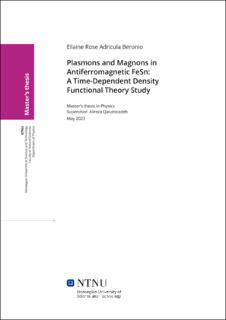| dc.description.abstract | This study is an exploration, via time-dependent density functional theory, of collective excitations in FeSn, a layered antiferromagnetic metal with a kagome structure. At present, interest in FeSn is spurred by novel properties promised by the predicted flat and linearly dispersive electronic bands of ideal kagome lattices.
This work focuses on plasmons, which are quanta of longitudinal charge density oscillations, in bulk and monolayer FeSn. Having been initially conceived as an exploration of the possibility of plasmon-magnon coupling, this thesis also includes a description of magnons, the quanta of spin-waves, in the bulk and monolayer forms of the material. While magnons have been discussed in existing literature on FeSn, plasmon behaviour in the material has yet to be described. The monolayer form of FeSn has not been explored in published papers, although efforts to synthesise FeSn thin films are ongoing.
From analysis of the dielectric function and loss function of FeSn for different wave vectors along the path $\overline{\Gamma M}$ of the first Brillouin zone, plasmons in bulk FeSn are found to be long-lived at the Brillouin zone boundary and the bulk plasmon dispersion is quadratic for larger wave vectors. In contrast, monolayer plasmons are short-lived and heavily influenced by the continuum of single-particle excitations that cause Landau damping and eventual plasmon decay. From the calculations, several points of departure from the expected plasmon dispersion curve for three-dimensional and two-dimensional systems have been observed for the bulk and monolayer, respectively. Most prominent is the gapped and nearly flat dispersion of monolayer plasmons. In relation to magnons, the dispersion for bulk FeSn along $\overline{\Gamma M}$ is found to agree with published reports, while calculations for the monolayer magnon dispersion produced unexpected features.
In bringing out deviations from analytical predictions, the findings open up avenues for further investigation into the collective excitations of FeSn. The results also highlight the value of examining real materials using ab-initio computational techniques that can, in principle, provide a more realistic description of material properties. | |
